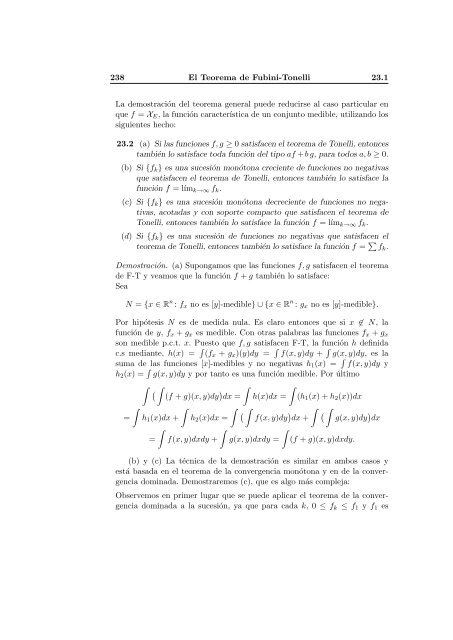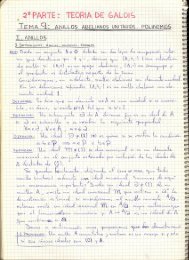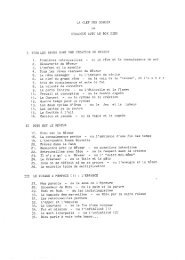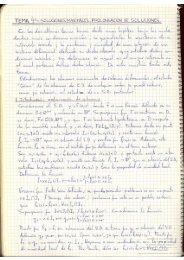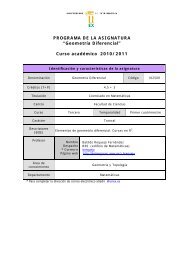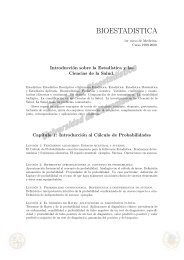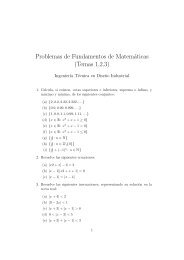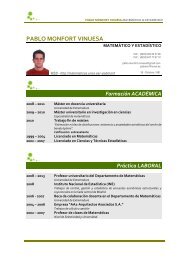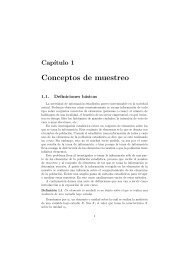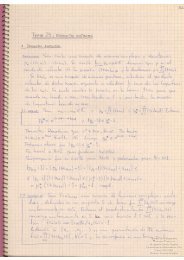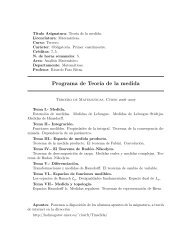El Teorema de Fubini-Tonelli
El Teorema de Fubini-Tonelli
El Teorema de Fubini-Tonelli
Create successful ePaper yourself
Turn your PDF publications into a flip-book with our unique Google optimized e-Paper software.
238 <strong>El</strong> <strong>Teorema</strong> <strong>de</strong> <strong>Fubini</strong>-<strong>Tonelli</strong> 23.1<br />
La <strong>de</strong>mostración <strong>de</strong>l teorema general pue<strong>de</strong> reducirse al caso particular en<br />
que f = XE, la función característica <strong>de</strong> un conjunto medible, utilizando los<br />
siguientes hecho:<br />
23.2 (a) Si las funciones f, g ≥ 0 satisfacen el teorema <strong>de</strong> <strong>Tonelli</strong>, entonces<br />
también lo satisface toda función <strong>de</strong>l tipo af + b g, para todos a, b ≥ 0.<br />
(b) Si {fk} es una sucesión monótona creciente <strong>de</strong> funciones no negativas<br />
que satisfacen el teorema <strong>de</strong> <strong>Tonelli</strong>, entonces también lo satisface la<br />
función f = límk→∞ fk.<br />
(c) Si {fk} es una sucesión monótona <strong>de</strong>creciente <strong>de</strong> funciones no negativas,<br />
acotadas y con soporte compacto que satisfacen el teorema <strong>de</strong><br />
<strong>Tonelli</strong>, entonces también lo satisface la función f = límk→∞ fk.<br />
(d) Si {fk} es una sucesión <strong>de</strong> funciones no negativas que satisfacen el<br />
teorema <strong>de</strong> <strong>Tonelli</strong>, entonces también lo satisface la función f = fk.<br />
Demostración. (a) Supongamos que las funciones f, g satisfacen el teorema<br />
<strong>de</strong> F-T y veamos que la función f + g también lo satisface:<br />
Sea<br />
N = {x ∈ R n : fx no es [y]-medible} ∪ {x ∈ R n : gx no es [y]-medible}.<br />
Por hipótesis N es <strong>de</strong> medida nula. Es claro entonces que si x ∈ N, la<br />
función <strong>de</strong> y, fx + gx es medible. Con otras palabras las funciones fx + gx<br />
son medible p.c.t. x. Puesto que f, g satisfacen F-T, la función h <strong>de</strong>finida<br />
c.s mediante, h(x) = (fx + gx)(y)dy = f(x, y)dy + g(x, y)dy, es la<br />
suma <strong>de</strong> las funciones [x]-medibles y no negativas h1(x) = f(x, y)dy y<br />
h2(x) = g(x, y)dy y por tanto es una función medible. Por último<br />
<br />
<br />
(f + g)(x, y)dy <br />
dx =<br />
<br />
h(x)dx = (h1(x) + h2(x))dx<br />
<br />
=<br />
<br />
h1(x)dx +<br />
<br />
<br />
h2(x)dx = f(x, y)dy <br />
<br />
dx + g(x, y)dy dx<br />
<br />
<br />
<br />
= f(x, y)dxdy + g(x, y)dxdy = (f + g)(x, y)dxdy.<br />
(b) y (c) La técnica <strong>de</strong> la <strong>de</strong>mostración es similar en ambos casos y<br />
está basada en el teorema <strong>de</strong> la convergencia monótona y en <strong>de</strong> la convergencia<br />
dominada. Demostraremos (c), que es algo más compleja:<br />
Observemos en primer lugar que se pue<strong>de</strong> aplicar el teorema <strong>de</strong> la convergencia<br />
dominada a la sucesión, ya que para cada k, 0 ≤ fk ≤ f1 y f1 es


